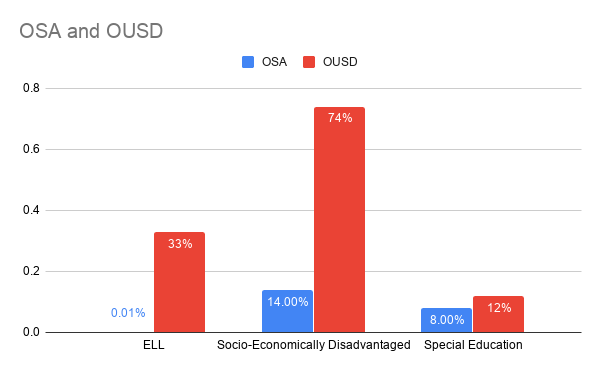"In the past month or so, OSA has been abuzz with talk of the recent charter renewal."
--Joaquin Montes De Oca, 7th grade
In the past month or so, OSA has been abuzz with talk of the recent charter renewal. Now, to start off, let’s break down what it really means to be a charter school as opposed to being a part of OUSD. A district school, which in Oakland means that you are a part of OUSD, means that you are one of the multiple district schools in Oakland. In contrast, being the public charter school that OSA is, we are a district unto ourself. This means that all decisions are made by OSA, rather than a district. However, in order to stay a charter, every 5 years there is a charter renewal. Essentially, the district evaluating whether or not OSA is worthy of another 5 to 7 years of OSA. When charter renewals are submitted, the district can present demands. In this year’s charter renewal, the district has demanded that OSA stop auditioning our incoming students in order to continue being a charter school.
This is a tricky and controversial predicament that seems to leave us with three options. But before we get to that, let’s delve into why exactly OUSD wants us to get rid of the audition. Officially, it is because, as we went over earlier, OSA, being a charter school, is a single district. At OUSD, if you don’t get into the school, you have somewhere else to go within that district, however, at OSA, if you don’t get in, you have no alternative OSA option. Although this is not the only issue with the audition, let’s hold off on that for a bit, though, and go over our three options.
The first option: Join OUSD.
With this option, we keep the audition but become a district school. Initially, it might seem that this is the option that would have the least drastic effect on our school. But there’s a catch. A few, actually.
“This is the part I'm kind of misinformed on,” says Grace Triantafyllos, an 8th grade Literary Arts student. “Like [I don’t know] the pros if we join OUSD but maybe that’s because there is nothing positive.”
“[Joining OUSD has] so many unknowns,” says Mike Oz, OSA Interim Principal. “I think it could have an impact on our teachers in terms of what kinds of credentials that they might need.” Oz is referring to the fact that many arts teachers don’t have teaching credentials required to teach at an OUSD school.
“I think it could impact our leadership structure and ultimately our budget and how we prioritize spending on the arts,” Oz goes on, proceeding to mention the possible relocation of our school that could be problematic and strenuous for OSA.
“Less control,” Says 8th grade Literary Arts student Leah Upton “They could change things and teachers and campus could move around.” All in all, most people seemed unsure when it came to this option.
The second option: Go on as a charter school without the audition.
“If we find that there’s five great things about the audition,” Oz says of OSA’s current enrollment process, “how can we get those another way. It’s not the audition that’s great, it’s the five things.”
This option is backed up by the reasons against option three (below). However, this seems to be a pretty unpopular option, as Triantafyllos stated her concern that incoming students who are un-auditioned might flounder.
The third and final option: Submit the renewal with the audition.
“I can definitely see how the audition process looks to many outside of OSA.” Jordan Karnes, Literary Arts Chair, “I think people think that we cherry pick for the most elite students, but it’s not like that. Yes, technical skill plays a factor for most departments at some level, especially departments like Vocal or Instrumental, but that is not the only thing we are looking for, not necessarily. Auditions are a place where students can advocate for themselves, where they can share their passion for their art—which I think is really important, considering how long of a day, and how much time students spend working on their art over the years. In Lit Arts, we have students of all skills and learning abilities. We have students for whom English is a second language. We have students who are dyslexic.”
The ideal outcome for many is that OSA will continue to be a charter school with the audition in place.
“I do think [OSA] needs an audition,” says Upton. “The audition shows that students will be willing to put in the work and be enthusiastic to participate.”
For the record, this is the most popular option, with a whopping 77% of the OSA community choosing this in a survey presented this fall. For that reason, let’s explore one reason that someone might have voted contrary to that: disproportionate enrollment.
Essentially, the main concern aside from there being no other school in our district is that some believe the audition is potentially biased against certain students, mainly four specific groups: socio-economically disadvantaged students, special education students, ELL (English Language Learner) students, and non-white students.
To start, socio-economically disadvantaged (low income) students might have difficulty getting into OSA for a bevy of reasons, one being general access to the level of training in their emphasis that has been provided to students who can afford it. This causes students with the same level of untapped potential or talent to be dismissed. This along with transportation issues, access to basic school resources and other difficulties make it that much more difficult for those students to get into OSA. To back this up, see the bottom of the article for the graph showing the gap between low-income students at OSA and at audition free district schools. You will find that while audition-free OUSD schools have 74% low-income students, OSA only has 14%.
The next group, special education students (12% in OUSD and 8% in OSA) could find it difficult to get into OSA for several reasons. For example, some might suffer from cognitive, speech or behavior, etc challenges that could negatively impact the judge’s perceptions despite the actual level of talent and dedication. This, along with lack of confidence based on prior experiences could make it more difficult. The percentages here will also be below.
With the high English speaking and or writing demands of departments like Theater and Literary Arts, with improper use of grammar, having an accent, different cultural use of language or the other difficulties of using an unknown language you might be able to see why it might be difficult for ELL students to get into OSA.
As for non-white students or students of color, it is clear in other graphs below that the gap between students of color and white students is striking, with OSA more than 40% white versus the 5.1% white in all other charter schools combined. Despite the Step It Up program instituted 5 years ago in the previous charter renewal in an attempt to make OSA more racially integrative, the final graph displays a purple/pink line representing the white student population that has over the years gone in a drastic upward arc to now, its all-time high at OSA.
What will our school decide? How will it affect OSA’s future? Only time will tell.
Graph's from:
Data Quest: dq.cde.ca.gov
OUSD Data: ousddata.org
Graph 1 shows the ethnic gap at OSA, Graph 2 shows ELL (English Language Learners, Special Education and Low Income.)
Click Links To See 1st Graph (2nd below):
https://dashboards.ousd.org/views/Enrollment/Historic?%3Aembed=y&%3AshowShareOptions=true&%3Adisplay_count=no&%3AshowVizHome=no&%3Arender=false#7 (Select Oakland School for the Arts in the Select School section.)
This is a tricky and controversial predicament that seems to leave us with three options. But before we get to that, let’s delve into why exactly OUSD wants us to get rid of the audition. Officially, it is because, as we went over earlier, OSA, being a charter school, is a single district. At OUSD, if you don’t get into the school, you have somewhere else to go within that district, however, at OSA, if you don’t get in, you have no alternative OSA option. Although this is not the only issue with the audition, let’s hold off on that for a bit, though, and go over our three options.
The first option: Join OUSD.
With this option, we keep the audition but become a district school. Initially, it might seem that this is the option that would have the least drastic effect on our school. But there’s a catch. A few, actually.
“This is the part I'm kind of misinformed on,” says Grace Triantafyllos, an 8th grade Literary Arts student. “Like [I don’t know] the pros if we join OUSD but maybe that’s because there is nothing positive.”
“[Joining OUSD has] so many unknowns,” says Mike Oz, OSA Interim Principal. “I think it could have an impact on our teachers in terms of what kinds of credentials that they might need.” Oz is referring to the fact that many arts teachers don’t have teaching credentials required to teach at an OUSD school.
“I think it could impact our leadership structure and ultimately our budget and how we prioritize spending on the arts,” Oz goes on, proceeding to mention the possible relocation of our school that could be problematic and strenuous for OSA.
“Less control,” Says 8th grade Literary Arts student Leah Upton “They could change things and teachers and campus could move around.” All in all, most people seemed unsure when it came to this option.
The second option: Go on as a charter school without the audition.
“If we find that there’s five great things about the audition,” Oz says of OSA’s current enrollment process, “how can we get those another way. It’s not the audition that’s great, it’s the five things.”
This option is backed up by the reasons against option three (below). However, this seems to be a pretty unpopular option, as Triantafyllos stated her concern that incoming students who are un-auditioned might flounder.
The third and final option: Submit the renewal with the audition.
“I can definitely see how the audition process looks to many outside of OSA.” Jordan Karnes, Literary Arts Chair, “I think people think that we cherry pick for the most elite students, but it’s not like that. Yes, technical skill plays a factor for most departments at some level, especially departments like Vocal or Instrumental, but that is not the only thing we are looking for, not necessarily. Auditions are a place where students can advocate for themselves, where they can share their passion for their art—which I think is really important, considering how long of a day, and how much time students spend working on their art over the years. In Lit Arts, we have students of all skills and learning abilities. We have students for whom English is a second language. We have students who are dyslexic.”
The ideal outcome for many is that OSA will continue to be a charter school with the audition in place.
“I do think [OSA] needs an audition,” says Upton. “The audition shows that students will be willing to put in the work and be enthusiastic to participate.”
For the record, this is the most popular option, with a whopping 77% of the OSA community choosing this in a survey presented this fall. For that reason, let’s explore one reason that someone might have voted contrary to that: disproportionate enrollment.
Essentially, the main concern aside from there being no other school in our district is that some believe the audition is potentially biased against certain students, mainly four specific groups: socio-economically disadvantaged students, special education students, ELL (English Language Learner) students, and non-white students.
To start, socio-economically disadvantaged (low income) students might have difficulty getting into OSA for a bevy of reasons, one being general access to the level of training in their emphasis that has been provided to students who can afford it. This causes students with the same level of untapped potential or talent to be dismissed. This along with transportation issues, access to basic school resources and other difficulties make it that much more difficult for those students to get into OSA. To back this up, see the bottom of the article for the graph showing the gap between low-income students at OSA and at audition free district schools. You will find that while audition-free OUSD schools have 74% low-income students, OSA only has 14%.
The next group, special education students (12% in OUSD and 8% in OSA) could find it difficult to get into OSA for several reasons. For example, some might suffer from cognitive, speech or behavior, etc challenges that could negatively impact the judge’s perceptions despite the actual level of talent and dedication. This, along with lack of confidence based on prior experiences could make it more difficult. The percentages here will also be below.
With the high English speaking and or writing demands of departments like Theater and Literary Arts, with improper use of grammar, having an accent, different cultural use of language or the other difficulties of using an unknown language you might be able to see why it might be difficult for ELL students to get into OSA.
As for non-white students or students of color, it is clear in other graphs below that the gap between students of color and white students is striking, with OSA more than 40% white versus the 5.1% white in all other charter schools combined. Despite the Step It Up program instituted 5 years ago in the previous charter renewal in an attempt to make OSA more racially integrative, the final graph displays a purple/pink line representing the white student population that has over the years gone in a drastic upward arc to now, its all-time high at OSA.
What will our school decide? How will it affect OSA’s future? Only time will tell.
Graph's from:
Data Quest: dq.cde.ca.gov
OUSD Data: ousddata.org
Graph 1 shows the ethnic gap at OSA, Graph 2 shows ELL (English Language Learners, Special Education and Low Income.)
Click Links To See 1st Graph (2nd below):
https://dashboards.ousd.org/views/Enrollment/Historic?%3Aembed=y&%3AshowShareOptions=true&%3Adisplay_count=no&%3AshowVizHome=no&%3Arender=false#7 (Select Oakland School for the Arts in the Select School section.)



